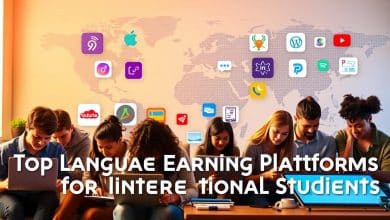How to Use Digital Libraries for Academic Research
Modern education thrives on instant access to information. Platforms like EBSCO, NYPL, and DPLA have transformed how scholars explore topics. These tools provide curated collections of journals, historical records, and multimedia materials—all available with a few clicks.
EBSCO supports institutions by managing subscriptions and streamlining discovery. The New York Public Library offers databases for genealogy, language learning, and article searches. Meanwhile, DPLA’s guides help users navigate its vast archives efficiently. Together, they serve millions globally, from students to professionals.
Accessibility is a cornerstone of these systems. No longer limited by geography or operating hours, users can study rare manuscripts or peer-reviewed papers at any time. This flexibility levels the playing field for those outside major institutions.
Resources range from specialized archives to open-access publications. Whether tracing family history or analyzing scientific data, there’s a tool tailored to the task. Such diversity ensures every project—from high school essays to doctoral theses—finds reliable support.
By removing physical barriers, these platforms empower deeper exploration. They’re not just repositories but dynamic spaces where curiosity meets opportunity. The next sections will show how to harness their full potential.
Introduction to Digital Libraries
Today’s information seekers often turn to virtual repositories instead of brick-and-mortar institutions. These systems store centuries of knowledge—from handwritten letters to interactive maps—ready for exploration from any device.
What Makes These Platforms Unique?
Unlike physical spaces, these repositories combine scanned books with multimedia tools and collaborative features. For example, the New York Public Library hosts millions of photos, manuscripts, and archives—all searchable online. Users can examine delicate 19th-century prints without handling fragile originals.
Platforms like DPLA take this further by curating primary sources on pivotal events. Their Civil Rights Movement exhibition combines speeches, photos, and protest posters into thematic sets. This approach transforms static artifacts into dynamic learning experiences.
From Card Catalogs to AI Search
The journey began with converting paper records into searchable databases. Early systems mimicked card catalog layouts. Modern platforms use metadata tagging and machine learning to connect related materials across continents.
“We’ve moved from hoping to find a book to expecting answers in seconds.”
Accessibility drives innovation. Screen reader compatibility and adjustable text sizes ensure everyone can explore materials. Institutions now prioritize inclusive design, recognizing that knowledge thrives when barriers fall.
Digital Libraries Academic Research: Key Strategies
Effective academic inquiry hinges on the ability to locate and assess trustworthy materials. With countless platforms available, distinguishing credible collections from superficial ones separates impactful work from unreliable outputs. Expert-curated tools simplify this process, offering structured pathways to verified information.
Identifying Quality Digital Collections
Start by prioritizing collections backed by established institutions. Platforms like EBSCO integrate discovery tools that highlight peer-reviewed journals and publisher-vetted materials. Check for clear editorial policies or partnerships with universities—these signals often indicate rigorous standards.
NYPL’s research guides exemplify this approach. Their staff-curated lists direct users to specialized databases tailored to subjects like economics or literature. This targeted navigation saves time and reduces reliance on generic search results.
Evaluating Digital Resources for Academic Use
Scrutinize three elements: authorship, currency, and citations. Reputable sources name authors with verifiable credentials and update content regularly. For example, historical archives should note digitization dates, while scientific databases often display impact metrics.
Compare specialized repositories with broader collections. A medical study might require clinical trial data from PubMed, whereas a sociology paper could benefit from DPLA’s multimedia civil rights materials. Always match the resource’s scope to your project’s needs.
Navigating Databases and Archival Collections
Mastering database navigation separates casual browsing from focused inquiry. Platforms like NYPL offer millions of scholarly books and archival materials—from congressional records to abolitionist manuscripts—all accessible through intuitive interfaces.
Effective Search Techniques and Filtering Tools
Precision begins with strategic queries. Use Boolean operators like AND/OR/NOT to connect terms. For example, searching “suffrage movement” AND newspapers yields targeted results from specific eras.
| Technique | Use Case | Example |
|---|---|---|
| Phrase searching | Exact matches | “Underground Railroad” |
| Field filters | Limit by author/date | creator:”Douglass, Frederick” |
| Subject headings | Thematic accuracy | LCSH: Slavery—United States |
Exploring Diverse Resource Types
Beyond text, collections contain photographs, maps, and audio recordings. NYPL’s early congressional documents show handwritten amendments, while their abolition archives combine letters with protest posters.
Consider format strengths:
– Articles offer condensed analysis
– Books provide deep context
– Multimedia reveals cultural nuances
Historical materials often require interpretation. A blurred 1850s photo might need cross-referencing with newspaper accounts. Always note digitization dates and collection origins to assess reliability.
Effective Access and Utilization of Digital Resources
Researchers today must master varied platforms to efficiently gather information. Institutions like EBSCO and NYPL offer distinct pathways to materials, while services like The Palace Project expand options through innovative partnerships.
Understanding Subscription Services and Access Models
EBSCO’s subscription packages include training tools that help users maximize features. Many universities bundle these services into campus-wide access, letting students log in through institutional portals. Public systems like NYPL complement this by offering free entry to millions of items—no affiliation required.
Three common models shape availability:
- Subscription-based: Paid through institutions (e.g., peer-reviewed journals)
- Open access: Freely available articles and historical archives
- Hybrid systems: Mix free/premium content based on user status
“Your library card is often the key to more materials than you realize.”
Integrating Platforms into Academic Workflows
Start by saving credentials in password managers for quick authentication. Use browser extensions like Zotero to capture citations directly from platforms. For collaborative projects, cloud storage syncs notes across devices.
Common hurdles include:
- Proxy server errors during off-campus access
- Expired sessions requiring re-logins
- Format conflicts when downloading files
Mobile apps from services like The Palace Project let users read ebooks during commutes. Meanwhile, shared folders in tools like Google Drive help teams organize findings without platform hopping.
Overcoming Common Research Challenges
Even seasoned investigators encounter roadblocks when accessing specialized materials. These hurdles range from paywalls to questionable source quality. Proactive strategies help maintain momentum while ensuring credible results.
Troubleshooting Limited Access and Subscription Barriers
Many platforms restrict content behind institutional logins. NYPL’s virtual reference desk helps users navigate these walls through alternatives like inter-library loans. Public library partnerships often unlock commercial databases at no cost.
Open-access repositories provide another pathway. Services like PubMed Central and JSTOR’s free collection offer peer-reviewed articles without subscriptions. Always check if your local library provides proxy access—many do through digital membership cards.
Ensuring the Reliability of Information in a Digital Format
Scanned documents may contain OCR errors or missing pages. Cross-reference multiple sources to confirm details. For example, compare a digitized newspaper article with physical archives or other databases.
Metadata inconsistencies can skew search results. Verify dates, authorship, and collection context before citing materials. NYPL’s accessibility features—like screen reader compatibility—help users spot discrepancies through enhanced navigation tools.
When uncertain, contact platform support teams. Most systems list contact options alongside their FAQ sections. This step often resolves issues faster than independent troubleshooting.
Real-life Examples and Applications from Leading Libraries
Leading institutions demonstrate how structured platforms elevate scholarly work. Through tailored tools and curated materials, they empower users to uncover insights across disciplines while maintaining rigorous standards.
Insights from EBSCO and NYPL Research Centers
EBSCO’s analytics dashboard helps universities track which journals faculty use most. This data informs budget decisions, ensuring funds support high-impact resources. Their discovery tools also reduce search time by 40% compared to traditional methods.
NYPL’s culinary magazine archives reveal food trends across decades. Researchers analyze advertisements and recipes to study cultural shifts. Their business databases help entrepreneurs verify market data through 16 million company profiles.
- Genealogy tools tracing immigration patterns
- Interactive maps showing historical land use
- Author-specific portals with manuscript drafts
How DPLA Guides Support Diverse Research Interests
DPLA’s “Race to the Moon” exhibition combines NASA transcripts with newspaper editorials. Students compare public sentiment with technical challenges faced during the space race. Primary source sets on the Transcontinental Railroad include worker diaries and engineering blueprints.
| Topic | Materials | Use Cases |
|---|---|---|
| Civil Rights | Protest posters, speeches | Sociology thesis research |
| Equal Rights Amendment | Letters, legislative drafts | Legal history analysis |
| Transatlantic Slave Trade | Ship manifests, abolition pamphlets | Demographic studies |
These platforms complement each other. A historian might cross-reference DPLA’s Fannie Lou Hamer materials with NYPL’s voting rights archives while using EBSCO to locate peer-reviewed analyses. This layered approach creates multidimensional projects.
Conclusion
The ability to explore knowledge from any location reshapes modern scholarship. Curated platforms simplify locating peer-reviewed articles, historical records, and multimedia materials. By combining advanced search techniques with critical evaluation skills, users transform scattered data into meaningful insights.
Success hinges on adaptability. As collections grow and tools evolve, researchers must stay curious about emerging formats. Verified sources remain essential—whether analyzing 19th-century manuscripts or contemporary datasets.
Strong projects blend traditional methods with new approaches. Cross-referencing physical archives with online materials often reveals overlooked connections. Institutions continually refine access models, ensuring diverse voices and perspectives stay accessible.
Mastering these systems unlocks opportunities across disciplines. From tracing family histories to supporting scientific breakthroughs, organized exploration turns questions into discoveries. Every subject benefits when seekers know how to navigate, assess, and apply information effectively.
FAQ
How do digital collections differ from traditional libraries?
What criteria help determine if an online resource is credible?
How can users efficiently search large databases?
What options exist for accessing subscription-only materials?
Why might some sources in virtual repositories lack reliability?
How do platforms like DPLA support specialized projects?
Can multimedia files from these platforms be cited in formal work?
Published on: 17 de August de 2025







